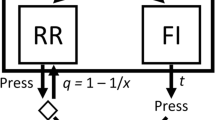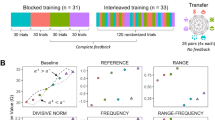Abstract
Previous research shows that relative initial- and terminal-link temporal duration influences concurrent chain choice proportions. However, little research has examined whether reinforcement outside of either links influences concurrent chain choice proportions and/or response rates. We examined this by conducting an experiment in which 11 pigeons responded on concurrent chain schedules that alternated with either fixed interval (FI) or fixed time (FT) reinforcement schedules. FI and FT schedules provided reinforcement every 20, 60 or 180 s. Concurrent chain schedules provided reinforcement on average every 60 s. Concurrent chain schedules were never available at the same time as the FI or FT schedule. Most pigeons decreased choice proportions as the temporal duration of the FI or FT schedules increased, similar to the initial-link effect. Consistent with behavior contrast research, initial link response rates significantly increased as reinforcement rate decreased during the FI and FT schedules. This is the first study to show that reinforcement outside of a concurrent chain schedule can significantly change choice proportions. The initial link response rate result suggests a novel way to look at initial link response rates, outside of changing reinforcement rates and temporal duration.


Similar content being viewed by others
Notes
Including pigeons 17 and EA1752 in the analysis resulted in the following results: For initial link choice proportions a repeated measures ANOVA showed no significant main effects for context schedule duration F(3, 30) = 2.49, p = 0.08 or response contingency F(1, 10) = 0.28, p = 0.61, but a significant interaction between context schedule duration and response contingency F(3, 30) = 3.50, p = 0.04, η2 = 0.26. For initial link, terminal link, and context schedule response rates, a repeated measure ANOVA showed identical results as when the two pigeons were excluded.
References
Fantino, E. (1969). Choice and rate of reinforcement. Journal of the Experimental Analysis of Behavior, 12, 723–730.
Fantino, E., & Davison, M. (1983). Choice: Some quantitative relations. Journal of the Experimental Analysis of Behavior, 40, 1–13.
Fantino, E., Preston, R. A., & Dunn, R. (1993). Delay-reduction: Current status. Journal of the Experimental Analysis of Behavior, 60, 159–169.
Fleshler, M., & Hoffman, H. S. (1962). A progression for generating variable-interval schedules. Journal of the Experimental Analysis of Behavior, 5, 529–530.
Goldshmidt, J. N., Lattal, K. M., & Fantino, E. (1998). Context effects on choice. Journal of the Experimental Analysis of Behavior, 70, 301–320.
Grace, R. C. (1994). A contextual model of concurrent-chains choice. Journal of the Experimental Analysis of Behavior, 61, 113–129.
Grace, R. C., & Bragason, O. (2004). Does the terminal-link effect depend on duration or reinforcement rate? Behavioural Processes, 67, 67–79.
Halliday, M. S., & Boakes, R. A. (1971). Behavioral contrast and response independent reinforcement. Journal of the Experimental Analysis of Behavior, 16, 429–434.
Hursh, S. R., & Fantino, E. (1973). Relative delay of reinforcement and choice. Journal of the Experimental Analysis of Behavior, 19, 437–450.
LaFiette, M. H., & Fantino, E. (1989). Responding on concurrent-chains schedules in open and closed economies. Journal of the Experimental Analysis of Behavior, 51, 329–342.
MacEwen, D. (1972). The effects of terminal-link fixed-interval and variable-interval schedules on responding under concurrent chained schedules. Journal of the Experimental Analysis of Behavior, 18, 253–261.
Mazur, J. E. (2001). Hyperbolic value addition and general models of animal choice. Psychological Review, 108(1), 96–112.
Mazur, J. E., & Fantino, E. (2014). Choice. In F. K. McSweeney & E. S. Murphy (Eds.), The Wiley Blackwell handbook of operant and classical conditioning (pp. 195–220). Oxford: Wiley-Blackwell.
Reynolds, G. S. (1961). Behavioral contrast. Journal of the Experimental Analysis of Behavior, 4, 57–71.
Shull, R. L., & Pliskoff, S. S. (1967). Changeover delay and concurrent schedules: Some effects on relative performance measures. Journal of the Experimental Analysis of Behavior, 10, 517–527.
Squires, N., & Fantino, E. (1971). A model for choice in simple concurrent and concurrent-chains schedules. Journal of the Experimental Analysis of Behavior, 15, 27–38.
Thompson, D. M., & Corr, P. B. (1974). Behavioral parameters of drug action: Signaled and response-independent reinforcement. Journal of the Experimental Analysis of Behavior, 21, 151–158.
Weisman, R. G., & Ramsden, M. (1973). Discrimination of a response-independent component in a multiple schedule. Journal of the Experimental Analysis of Behavior, 19, 55–64.
Williams, B. A. (2002). Behavioral contrast redux. Animal Learning & Behavior, 30, 1–20.
Williams, B. A., & Fantino, E. (1978). Effects on choice of reinforcement delay and conditioned reinforcement. Journal of the Experimental Analysis of Behavior, 29, 77–86.
Williams, W. A., & Fantino, E. (1996). Response-dependent prochoice effects on foraging related choice. Journal of the Experimental Analysis of Behavior, 65, 619–641.
Author information
Authors and Affiliations
Corresponding author
Ethics declarations
Funding
None
Conflict of Interest
All authors declare they have no competing interests.
Ethical Approval
Chico State’s Animal Care and Use Committee (ACUC) approved all procedures prior to experimentation. Pigeons were cared for according to the standards described in California State University, Chico’s Animal Welfare Policy. All applicable international, national, and institutional guidelines for care and use of animals were followed.
Informed Consent
No human participants were enrolled.
Rights and permissions
About this article
Cite this article
Romanowich, P., Cozine, A. & Worthen, D.L. Effects of Reinforcement Context on Initial Link Responding in Concurrent Chain Reinforcement Schedules. Psychol Rec 67, 43–50 (2017). https://doi.org/10.1007/s40732-016-0204-1
Published:
Issue Date:
DOI: https://doi.org/10.1007/s40732-016-0204-1




